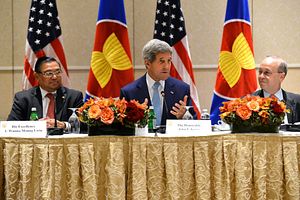With the Obama administration entering its last days of an election year, the Chinese have enjoyed an unhindered diplomatic ride over regional affairs and regained an upper hand in their bid to control the international waterways of the South China Sea.
This was highlighted by Beijing’s embrace of Filipino President Rodrigo Duterte who is delighting himself and his Chinese counterpart Xi Jinping with threats to spoil his country’s historical alliance with the United States and key allies like Japan and Australia.
His efforts in China even outshone the extra-judicial killings he initiated – now in the thousands – with a focus on drug dealers and offered some insight into his thinking. Old loyalties are not one of his strengths as he effectively sought to undermine Washington’s rebalance towards Asia.
As a public relations stunt, it was an impressive performance. But as an exercise in thoughtful foreign policy – in a world bedeviled by dangerous and competing sovereign interests – Duterte’s efforts were simplistic and self-serving at best.
But there are much bigger issues confronting Washington’s rebalance to Asia. According to a report by Professor James Petras of Global Research, those issues have been led by a failure to shift existing resources from regions like the Middle East towards East Asia.
Instead, President Barak Obama and former Secretary of State Hillary Clinton simply added military commitments to the region, while provoking more conflicts with Russia and China, he wrote in his latest report to the center.
“The entire US strategy of retaining global supremacy depended on securing and enhancing its control over its regional allies and proxies,” he recently wrote under the banner Washington’s ‘Pivot to Asia’: A Debacle Unfolding.
“Failure of the Obama regime to retain Washington’s vassal states would accelerate its decline and encourage more desperate political maneuvers.”
To be sure, “vassal” is hardly an appropriate description of bilateral, or multilateral, U.S. ties in the region. Japan to the United States is hardly comparable with Cambodia to China.
While Petra’s choice of words are on the undergraduate side of analysis and this report does read like it was written by a pro-Communist lobbyist at the height of the Cold War, his points should nonetheless be heard. There are deep ramifications for the next president of the United States.
Washington’s influence with Thailand has waned, while the election of Duterte has cast serious doubts over the alliance, which means both of the U.S. treaty alliances in Southeast Asia are in trouble. U.S. influence in aid-dependent Cambodia has been outbid by Chinese largesse, while Singapore – a key regional power broker – and Malaysia are hedging their bets.
Unity and military muscle going into 2017 will provide the biggest of headaches in Southeast Asia, where defense spending is at an historical low while Chinese money continues to pour in. An escalating arms race is looming for the next president, whether or not it is Hillary Clinton or Donald Trump who moves into the White House.
However, fresh alliances with the potential to reshape regional dynamics have also emerged from the shadows in recent times. These should aid freedom of navigation in the South China Sea while countering Beijing’s own military industrial complex.
Angered by Chinese encroachment across their maritime boundaries, and aided by a dose of traditional enmity – Indonesian and Vietnamese bilateral ties with the US will prove crucial, while the emergence of fresh leaders in Laos and Myanmar also bodes well for the United States.
As Petras correctly points out, efforts to build the Trans-Pacific Partnership (TPP) – a trade bloc designed without Beijing’s involvement – is also flagging and the Chinese have also got the advantage, unlike the United States, of being in the region and involved in deals such as the Regional Comprehensive Economic Partnership (RCEP).
But in a post-Brexit era such trade deals are losing their appeal, particularly in democratic countries where a popular backlash against globalization can be measured at the ballot box.
Still, the economic card, according to Petras, remains significant.
“The “pivot to Asia” meant that the United States was extending and deepening its regional military alliances in order to confront and encircle Russia and China. The goal would be to cripple their economies and foster social unrest leading to political instability and regime change,” he insists.
Given the current state of the Russian and Chinese economies, the Americans may well have won the latest economic bout with its rivals – not unlike Washington’s defeat of the Soviet Union in the late 1980s – if indeed that is what it was.
However, U.S. economic might is also questionable. Its inability to resolve escalating debt and it’s use of quantitative easing policies to fund the Obama administration means it is hardly faring much better.
That also means that all three powers, going forward, will have to engage in tricky negotiations with their own people, asking how much are they willing to sacrifice in order to meet perceived threats in the South China Sea and East Asia, where Washington’s rebalance has stalled.
Luke Hunt can be followed on Twitter @lukeanthonyhunt

































